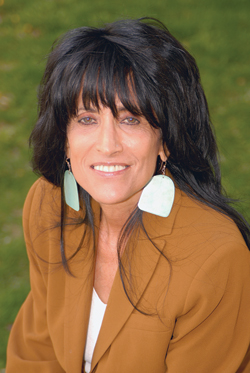
|
|
About Continuum Advertising Advisory Committee Archives Contact Us Continuum Home Faculty/Staff Subscribe related websites Alumni Association Marketing & Communications University of Utah Home |

And Finally...Q & A: Beverly Fenton, Director, American Indian Resource Centerby Colleen Casto  Beverly Fenton
In January, Beverly Fenton became the first full-time director of the American Indian Resource Center (AIRC) since it was established in 1996. Her responsibilities include participating in the recruitment of American Indian students and the development of programs for student retention, working closely with Utah Indian tribes, consulting with tribal education departments, collaborating with school programs K-12 regarding access to and participation in higher education, and helping create mentoring programs and campus cultural activities for American Indian students. Fenton, who is Ojibwe (Chippewa), came to the position with extensive experience leading successful university-level support programs for American Indian students. She has a master’s degree in education from Eastern Illinois University and is one of the original founders of the AIRC. What are your immediate goals for the AIRC? I want to begin to build the AIRC into a welcoming meeting and work space where students feel supported while they learn. The center is housed in a beautiful building along Officer’s Circle at Fort Douglas but has outdated equipment and computers. I hope to create a new computer lab and a resource-lending library, not only for American Indian students but for anyone interested in subjects such as law, sovereignty, politics, history, and so forth, as they pertain to American Indians. I also want to continue to build connections with the tribal colleges (those owned and administered by tribes throughout the nation) to share ideas, speakers, and resources, and create a student exchange program. Tribal colleges build retention of culture and language into their curricula. What are the challenges you face as the new director? Of course funding is always needed. I’ll be working on grant writing and managing the resources we have in place. Second, recruitment and retention of American Indian students are challenges. As a first-generation student, I felt marginalized in college, but with a supportive mentor I was able to complete undergraduate work and then a master’s degree. That’s why I believe mentoring programs are essential to help American Indian students succeed. The U needs to be proactive in finding and supporting these students who are bright, full of potential, and belong here. American Indian students also need scholarships. Many of them come from modest backgrounds and regard taking on a student loan as “out of their realm of reality.” I hope to establish a scholarship program for bright students who need financial assistance. I’d like to give donors the opportunity to get to know the AIRC and our students. In many cases this would bring together people from very different cultures and backgrounds. Tell us a bit about your experience as an American Indian in higher education. I have run the gamut from being a first-generation, 18-year-old freshman at a large flagship university, to a single parent, nontraditional-aged student. My experiences have given me personal insight into the challenges American Indian students face today. I chose my career path based on my personal commitment to make navigating higher education an easier process for others than it was for me. As a freshman, I went to my advisor for advice about my classes and was told that the freshman year was for “weeding out” those who didn’t belong. Years later, with a 4.0 GPA, I received a minority scholarship for graduate school. One of my professors told me right off that he did not believe minorities were as smart as other students and that my scholarship meant little. When I graduated with my master’s degree, he congratulated me on being a “credit to my race.” There were other experiences, as well. Having now worked in higher education for several years, I’ve found that American Indian students today face the same attitudes; however, it is more covert than overt. The existence of support services like CESA [the U of U Center for Ethnic Student Affairs] and the American Indian Resource Center are vital to ensuring that our students succeed. What are some of your memorable experiences with American Indian students at the U? I remain in contact with many of my former students from when I was the CESA advisor from 1991-1997. One student dubbed my office the “Big Top Circus” because there were always so many things going on. Another student arrived at the U with no reality about going to college. He had little money and was living in his car. He is now an environmental engineer. Many students have professional careers in Salt Lake. I’m in contact with students from Washington, D.C., to California and points in between. They send pictures of their families, stop by to see me, and write often. All have enriched my life in ways for which there are no words and have made me a better person for having known them. |